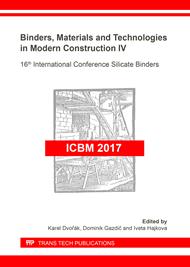p.134
p.140
p.148
p.154
p.160
p.167
p.173
p.179
p.185
Special Grout for Anchoring Steel Elements with High Proportion of Fly Ash Contaminated by Denitrification Process
Abstract:
This paper focuses on the possible use of fly ash contaminated by denitrification process as filler for special grouts based on epoxy resin. This fly ash is contaminated by combined ammonia ions as a consequence of flue gas denitrification. When mixing this fly ash with water and silica materials, ammonia (NH3) is released, therefore its application in these materials is inappropriate. The use of such fly ash as filler in polymeric substances, e.g. epoxy, polyester or vinyl ester resin, seems to be appropriate. When mixing fly ash with these materials, fly ash particles become coated with a polymeric substance, therefore no toxic ammonia is released. In the experiment, the impact of two kinds of contaminated fly ashes (FA-1, FA-2) and different percentages of filler in a polymer grout was examined on the resulting physical and mechanical properties. It was found that the best properties were by the grout with fly ash from circulating fluidized bed combustion from the Kladno thermal power plant (FA-1) under 45% of filling. This material showed high compressive and three-point bending strength and the flexural modulus was even higher than in the case of the reference material, which contained reference silica sand with optimal round grain shape as filler. Furthermore, chemical resistance of these materials against aggressive liquid solutions used in industrial operations were examined. An ideal grout formula was checked in a cut of an embedded steel element under optical microscope. A pull-out strength test was also performed in the case of the best formulas to determine the anchoring rate of embedded steel rod.
Info:
Periodical:
Pages:
160-166
Citation:
Online since:
June 2018
Authors:
Keywords:
Price:
Сopyright:
© 2018 Trans Tech Publications Ltd. All Rights Reserved
Share:
Citation:


